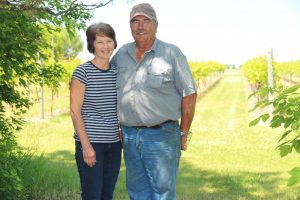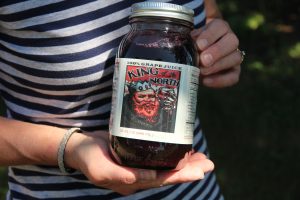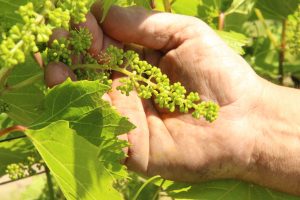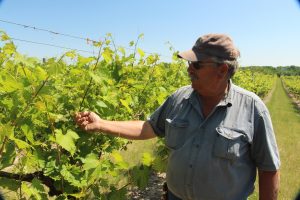
Sue and Jon Roisen at their Dawson Farm where they produce corn, soybeans and wine grapes.
Written by Jonathan Eisenthal
When Jon Roisen gave up his farrow/feed hog operation around the turn of the 21st century, he felt a bit of a void. He and his son Aaron were leafing through an AURI publication celebrating the relatively new cold-hardy wine grape variety, pioneered by University of Minnesota, called Frontenac.
They looked at each other and said yes to wine grapes.
Aaron went to New Zealand to learn oenology and the art of being a vintner, and in 2001, Jon and Susan Voight planted Frontenac wine grapes in an acre carved out of their corn and soybean operation.
Jon had done his homework, which is what he advises all start-up grape growers to do.
“Have a home for your fruit before you plant it,” Jon said. “Find out what the buyer wants. Don’t plant something you want to grow and then find a home for it. You’ve got to have all your ducks in a row before you go and do this, because the grapes may be an annual crop, but the vines are a perennial plant. You’re going be stuck with it. I can speak from experience: tearing out a variety, even just an acre, is a lot of work.”
Adding diversity
Overall, becoming a wine grape grower has offered the diversification the Roisens were looking for.
They’ve worked with three wine varieties, and now Susan has gotten into the table and grape juice trade, planting an additional two acres to a grape variety specifically for these uses. Some years in the making, “King of the North,” a pure, unfiltered grape juice brand, has been launched by Susan, who puts up about 1,200 quart jars a year. She mostly sells out her entire production right off the farm in one weekend in October — during The Meander, the annual art crawl along the Upper Minnesota River valley. Roisens are one of 40 stops.

Sue Roisen has launched her own brand of grape juice, King of The North.
Susan likes to cut “King of the North” with sparkling water and serve it as bubbly grape juice to the kids, while other buyers simply mix it with water to get just the right taste. One of her art crawl customers admitted to using “King of the North” as her favorite mixer in vodka cocktails. The Meander becomes a family affair: daughter Martha, a fiber artist, comes back to the farm from Portland, Ore., to offer clothing and table linens made using Shibori, a Japanese technique that combines pulled thread and fine stitching. Martha also sells these items out of the Yarnery in St. Paul. Online, Martha sells knitting patterns from her website, Kikoroo.com.
Aaron never made it back to the home wine grape operation in Dawson, though his folks continue to hope that some day he will. Aaron has become an award-winning vintner for Hosmer Winery, on the shores of Cayuga Lake, in the Finger Lakes region of New York state. There he is working with vinifera grape varieties (which originate in the Mediterranean zone) to produce a dry Riesling and a dry Rose. The Finger Lakes have a micro-climate out to a mile from shore, that is one growing zone more temperate than the surrounding region. Beyond that one mile shoreline zone, upstate New York grape growers work with the same Minnesota-pioneered varieties that Jon and Susan Roisen work with.
Grape varieties
Frontenac wine grapes have worked out well for the Roisens, as has Marquette — though the clusters are small, and would be much too labor intensive to pick by hand. The Roisens also tried Marchal Foch, but that had to be chalked up to experience after about five disappointing harvests.

Jon Roisten shows a grape vine bloom with its ‘caps’ — the little buds that will become grapes.
“It’s a fantastic grape and makes a great wine, but it just doesn’t make it through the Minnesota winters. It’s susceptible,” Roisen said.
The thought has crossed their minds, to launch a vineyard, but they came down on the ‘no’ side of the question considering the sparse population in Lac Qui Parle county. Though the New Ulm-St.Peter-Mankato region is still largely rural in character, there are 100,000 residents and lotsof touring visitors.
So Jon and Susan remain content to sell their grapes to Morgan Creek and Chankaska wineries, in New Ulm and St. Peter, respectively — a 120 miles trip in the semi each way.
The Roisens reached a good size for their fruit operation (10 acres) after eight years of adding an acre or two a year. They are about to write a new chapter in their family farm history.
“We haven’t done a major (wine grape) expansion in seven years,” Jon said. “University of Minnesota has just announced the name of a new white wine grape variety called Itasca, and there will be limited availability — tissue cultured plants only, which means little tiny pots with a small vine growing in it. It’s sensitive. You can’t plant them until the middle of June. I am 63 years old now, and I am going to do a two-acre expansion in 2018 of this variety. It is the hardiest variety they have introduced. It is really approaching levels of low acidity. It is an exciting variety.
“It could be like 300-bushel corn, to give you an idea. As far as hardiness, it would withstand the full vortex winter we had two years ago with only 10 percent bud death, whereas with all the other varieties, we had up to 40 percent bud death in some instances. This plant is amazing.”
Careful conservationists
To keep the corn, bean and grapes operation in good working order, Roisens are careful soil conservationists — as are their neighbors, says Jon. It’s true for their grapes, as much as their corn and beans. Jon bought a French-built vineyard composting machine that picks up the vine cuttings in the fall, up to four-inch branches and pulverizes them for mulch to feed the vines.
“It’s like a baler with a hammer mill on the back end. It can turn those four inch branches into tooth picks.”

Jon Roisten checks the progress of his vines, which will produce ‘Frontenac’ wine grapes.
Rather than wasting those nutrients, all the potash and phosphates bound up in that wood return their nutritional benefit to the grape vines. And conservation has been a principle in their row crop operation since Jon farmed with his dad.
“This year, I’d say a third of my beans are no-till,” Jon said. “It depends on the land, on the soil type. We do it where it’s needed. I farm quite a bit of land that is small fields. It’s hilly and rolling. We use shelter belts (of trees and shrubs), filter strips, and we plant along contours. We don’t have many square corners. Lots of point rows.”
Susan, a nurse by profession, has planted and combined their entire harvest some years (her Christmas present one year was the new combine!). She and Jon see precision agriculture as the future of land stewardship and conservation, and also keeping the farm operation in the black.
“With our planting in the coming year, we plan to use row shut offs (programmed into the planter using GPS) just for the saving of seed alone it will pay for itself in one year.”

